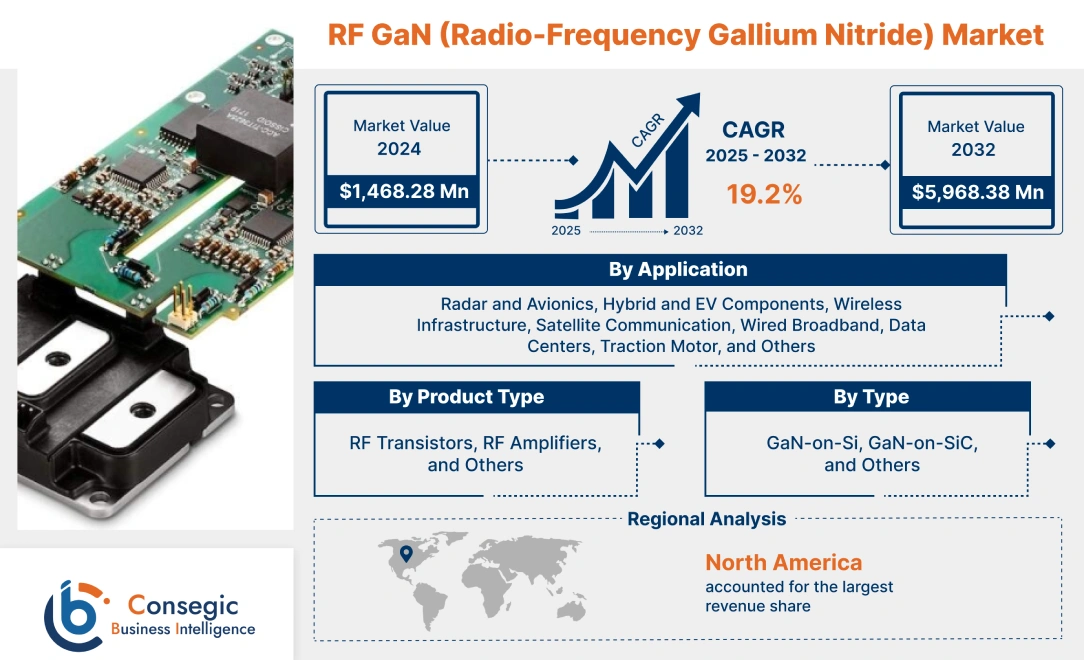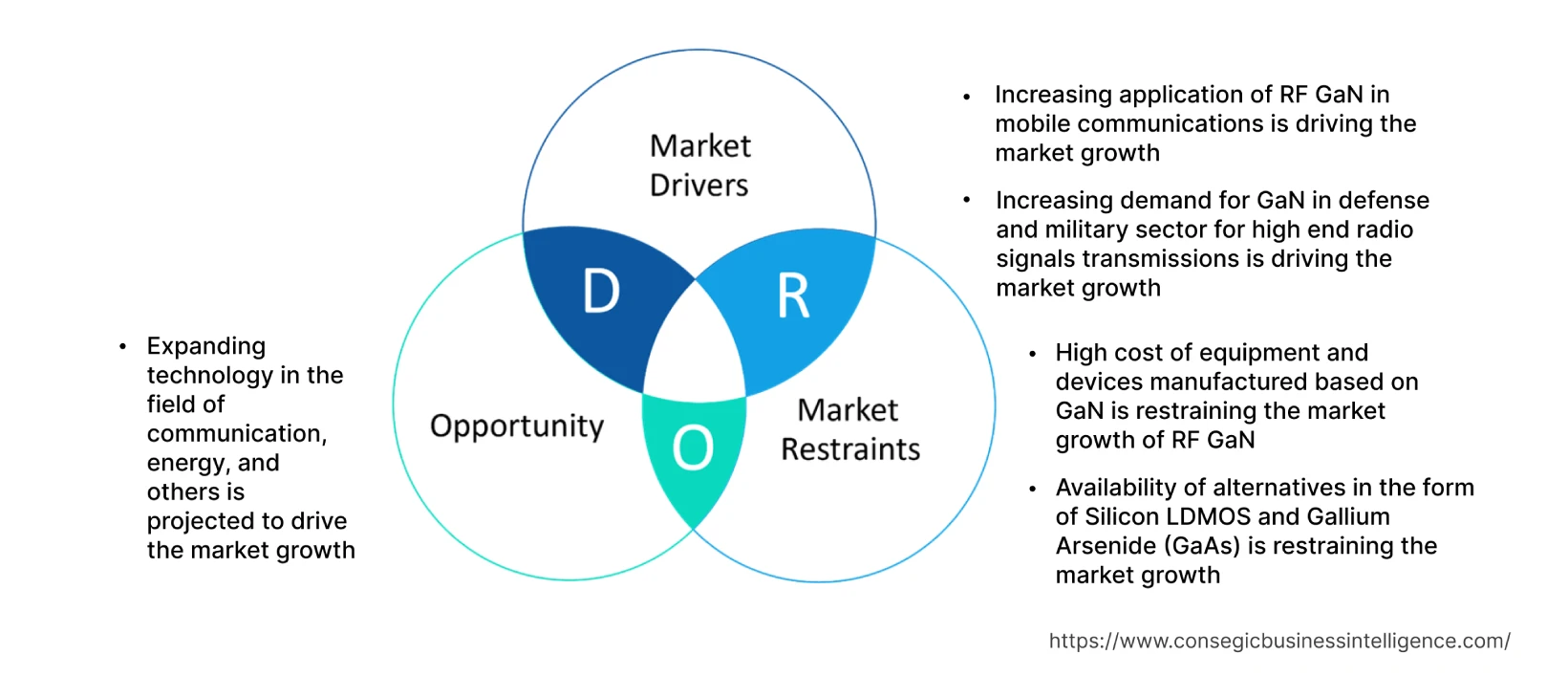- Summary
- Table Of Content
- Methodology
RF GaN (Radio-Frequency Gallium Nitride) Market Introduction :
RF GaN (Radio-Frequency Gallium Nitride) Market size is estimated to reach over USD 5,968.38 Million by 2032 from a value of USD 1,468.28 Million in 2024 and is projected to grow by USD 1,723.44 Million in 2025, growing at a CAGR of 19.20% from 2025 to 2032.
RF GaN (Radio-Frequency Gallium Nitride) Market Definition & Overview:
GaN (Gallium Nitride) is a leading high power technology in the field of semiconductor for delivering high frequency applications. GaN is considered as an ideal substrate for high frequency related radio frequency applications including wireless communications, microwave, electrical components, among others. Owing to key features exhibited by GaN including high efficiency, high power density, thermal conductivity, and others are promoting its market growth for RF applications.
Moreover, RF GaN has wide utlizations in the field of defense leading to its use in radar and avionics systems. In addition, key properties rendered through RF GaN by means of improved connectivity in wireless communications networks, radio communcations, and others is promoting the market growth. For instance, In June 2022, Qorvo Inc. was selected by U.S. Department of Defense (DoD) to process with STARRY NITE program towards development of open SOTA RF GaN foundries in collaboration with domestic market.
RF GaN (Radio-Frequency Gallium Nitride) Market Insights :
Key Drivers :
Increasing application of RF GaN in mobile communications is driving the market growth
GaN based devices have high end utilization in advanced RF applications including mobile communications with the existing radio spectrum. The advent of internet technology such as 5th Generation is more likely to be used with higher radio frequencies for better communication. Owing to its prominent features rendered by GaN including high electron mobility, high breakdown voltage, high current density, and others is proliferating the growth of RF GaN.
GaN are more advanced in comparison to traditionally used GaAs (Gallium Arsenide) and Si being employed for 4th Generation telecommunication. Moreover, aforementioned key properties of GaN are offering higher energy efficiency for its utilization in power amplifiers (PAs) that lie in front-end modules of mobile devices. The key role of front-end modules in mobile devices is to emit radio signals to and from the antennas, thus providing a higher transmission range to drive the antennas. Furthermore, GaN helps in optimizing mobile devices to operate at higher frequencies and is driving the market growth of RF GaN market.
For instance, imec, an innovator company, is focusing on GaN for its wider applications in advanced RF towards lower mmWave mobile communications. Therefore, with the growing application of GaN substrate for radio signaling process is driving the market growth for RF GaN.
Increasing demand for GaN in defense and military sector for high end radio signals transmissions is driving the market growth
GaN has revolutionized the aerospace and defense sector with its wide applications in the field of communication and signal transmissions. Radio signals emitted by radio frequencies are widely used in the aforementioned industry for applications including radar, military communication, and electronic warfare.
Moreover, high power semiconductor devices are largely in demand for the manufacturing of critical components in the aircraft and related equipment for military and aerospace industry. Equipment manufactured from RF GaN for military applications is employed for surveillance, foreign object detection, exploration and detection, among others. In addition, with the growing requirements for powerful amplifiers and transistors for signal boost and early detection measures within aircrafts and military vehicles is further proliferating the growth of RF GaN market.
Key Restraints :
High cost of equipment and devices manufactured based on GaN is restraining the market growth of RF GaN
The key reason for the slower growth of RF GaN market is due to the high cost of GaN in comparison to its counterparts i.e., GaAS and Si. High material cost of GaN and its less abundance tends to reduce the demand for RF GaN among small signal Monolithic Microwave Integrated Circuit (MMIC) and Low Noise Amplifier (LNA) devices is further restraining the market growth. Furthermore, its cost of manufacturing by reaction of Ga2O3 with NH3 at high temperature of 1000 degree Celsius raises the cost of final product, that ultimately inflates the price of GaN. Thus, owing to aforementioned limited applications and high cost of manufacturing is restraining the market growth RF GaN market.
Availability of alternatives in the form of Silicon LDMOS and Gallium Arsenide (GaAs) is restraining the market growth
Silicon LDMOS and Gallium Arsenide (GaAs) are widely known technologies that are in application for a longer duration owing to their low cost. Moreover, Silicon LDMOS has a higher rate of utilization in RF power application products including cellular base stations, broadcast transmitters, and others. In addition, GaAs and silicon LDMOS offer equal benefits including good power storage and handling coupled with high electron mobility is limiting the utility of GaN based Radio Frequency market.
Future Opportunities :
Expanding technology in the field of communication, energy, and others is projected to drive the market growth
The advent of technology including implementation of IoT (Internet of Things) in communication sector is boosting the market growth of RF GaN. Factors including high rate of utilization of IoT based devices due to growth in 5G technology is projected to boost the communication among IoT associated devices. Moreover, with the growth of energy storage devices for handling of high power tends to further boost the demand for RF GaN during the forecast period.
RF GaN (Radio-Frequency Gallium Nitride) Market Report Insights :
| Report Attributes | Report Details |
| Study Timeline | 2019-2032 |
| Market Size in 2032 | USD 5,968.38 Million |
| CAGR (2025-2032) | 19.2% |
| By Type | GaN-on-Si, GaN-on-SiC, and Others |
| By Product Type | RF Transistors, RF Amplifiers, and Others |
| By Application | Radar and Avionics, Hybrid and EV Components, Wireless Infrastructure, Satellite Communication, Wired Broadband, Data Centers, Traction Motor, and Others |
| By Region | North America, Europe, Asia-Pacific, Latin America, and Middle East & Africa |
| Key Players | Qorvo, Inc., Analog Devices, Inc., Aethercomm, WOLFSPEED, Inc., Integra Technologies Inc., MACOM Technology, Mitsubishi Electric Corporation, STMicroelectronics, Raytheon Technologies Corporation, MaxLinear, Microsemi, NXP Semiconductors, Sumitomo Electric Industries, Ltd., Mercury Systems, Inc. |
RF GaN (Radio-Frequency Gallium Nitride) Market Segmental Analysis :
Based on the Type :
The type of segment is segmented into GaN-on-Si, GaN-on-SiC, and Others.
The GaN-on-SiC segment accounted for largest market share of 52.4% in the RF GaN (Radio-Frequency Gallium Nitride) market in 2024. Owing to key features offered by GaN-on-SiC based on thermal conductivity that allow the devices to operate at higher power density and higher temperatures is driving its market growth under the type of segment category. Moreover, GaN-on-SiC is considered as a perfect match that lowers the defect density of crystals and reduces leakage thus improving the reliability of products tends to further drive its market growth.
For instance, in August 2020, MACOM Technology launched a new product line of power amplifiers, MAPC-A1000 and the MAPC-A1100 based on GaN-on-SiC category thus boosting its application across various industries.
Moreover, GaN-on-Si segment is expected to grow with the fastest CAGR during the forecast period. GaN-on-Si technology exhibits valuable deposition considered based on cost factor. Moreover, GaN-on-Si is capable of operating at considerable voltage that will inflate its application for small devices that tend to operate at lower voltage.
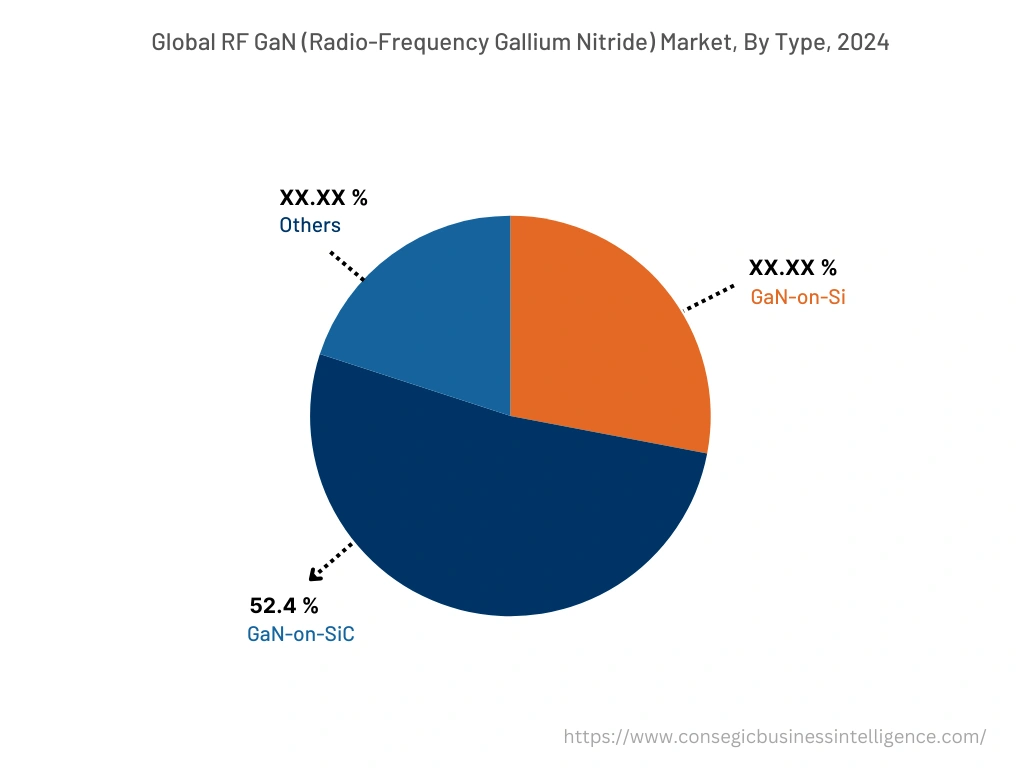
Based on the Product Type :
The product type segment is trifurcated into RF Transistors, RF Amplifiers, and Others
The transistors segment accounted for largest market share in the RF GaN (Radio-Frequency Gallium Nitride) market in 2024. Application of GaN transistors has been widely in application since long decade since its first introduction in the form of HEMT (High Electron Mobility Transistor) developed by Eudyna Corporation. Features including high linearity, broad frequency range, and high power density have been boosting the market growth for GaN based RF transistors. Moreover, growing requirements of electronic systems that exhibit high frequency and power are driving the market growth of the RF Transistors segment.
Amplifiers segment is anticipated to register the fastest CAGR in the RF GaN (Radio-Frequency Gallium Nitride) market during the forecast period. The growth of amplifiers is attributed to wide applications for equipment to amplify the radio signals required for telecommunication systems. Moreover, with the expansion of aerospace and defense industry across the globe is projected to further boost the market growth during the forecast period. For instance, in December 2021, CAES launched wideband, GaN-Based, high-power RF Amplifier for electronic warfare systems for aerospace and defense sector.
Based on the Application :
The application segment is segregated into Radar and Avionics, Hybrid and EV Components, Wireless Infrastructure, Satellite Communication, Wired Broadband, Data Centers, Traction Motor, and Others.
Radar and avionics hold the largest market share in 2024 and is also predicted to witness the fastest CAGR in the RF GaN (Radio-Frequency Gallium Nitride) market during the forecast period. Owing to the growing demand for high end products that are operational at different radar band is fueling the market growth of RF GaN within radar and avionics segment. For instance, Qorvo, Inc. has introduced QPM2637, Gallium Nitride MMIC front-end module (FEM) specifically designed to operate at X-Band radar within 9-10.5 GHz frequency. In addition, QPM2637 is fabricated on QGaN25 0.25um GaN-on-SiC process.
Based on the Region :
The regional segment includes North America, Europe, Asia Pacific, Middle East and Africa, and Latin America.
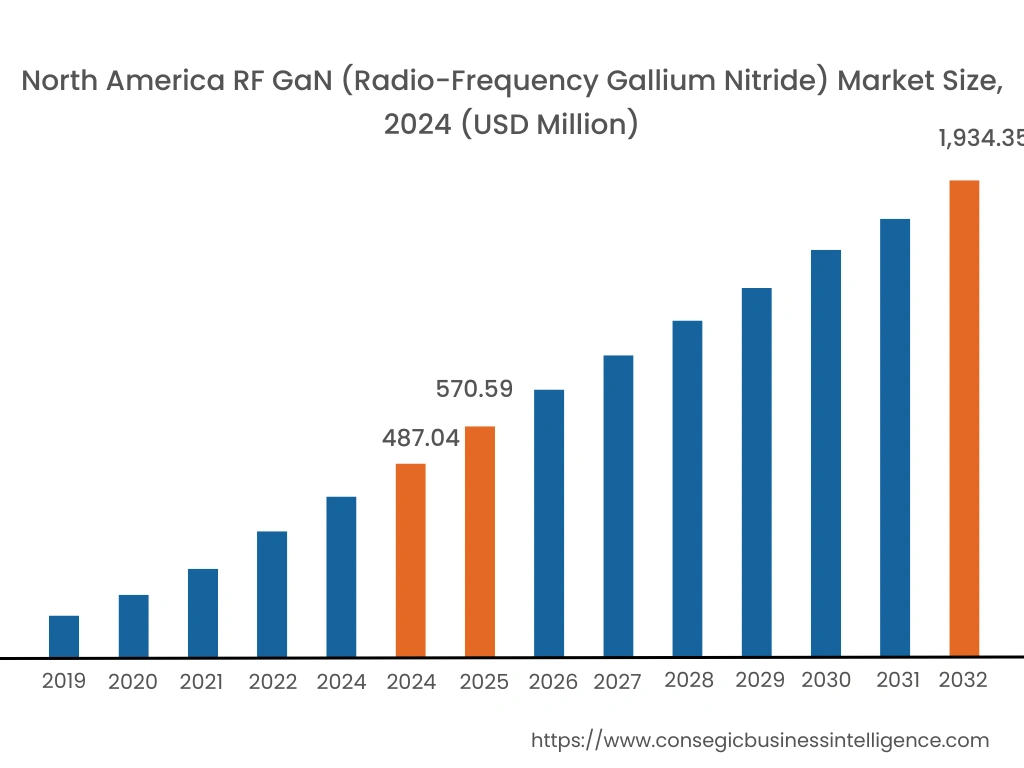
North America is estimated to reach over USD 1,934.35 Million by 2032 from a value of USD 487.04 Million in 2024 and is projected to grow by USD 570.59 Million in 2025. In addition, in the region, the U.S. accounted for the maximum revenue share of 58.56% in the year 2025. North America is contributing significantly to the research and development of GaN based products owing to the presence of key players including MACOM Technology, Qorvo Inc., WOLFSPEED, Inc. and others. The region is continuously witnessing growth in sectors including semiconductors, aerospace and defense, communication, and others is proliferating the growth of RF GaN market. For instance, in December 2021, Transphorm, Inc. received a contract of USD 0.9 million from the U.S. Defense Advanced Research Projects Agency (DARPA) to manufacture GaN solutions for commercial and Department of Defense (DoD) radio frequency applications.
Asia-Pacific region is anticipated to witness fastest growth at a CAGR of 19.6% during the forecast period. Owing to the factors including rapid pace of urbanization, industrialization, and development in the region is creating lucrative opportunities for market growth in the region. Moreover, expanding defense and telecommunication in the region owing to increasing deployment of 5G networks is expected to positively impact the adoption of RF GaN technology in the region during the forecast period.
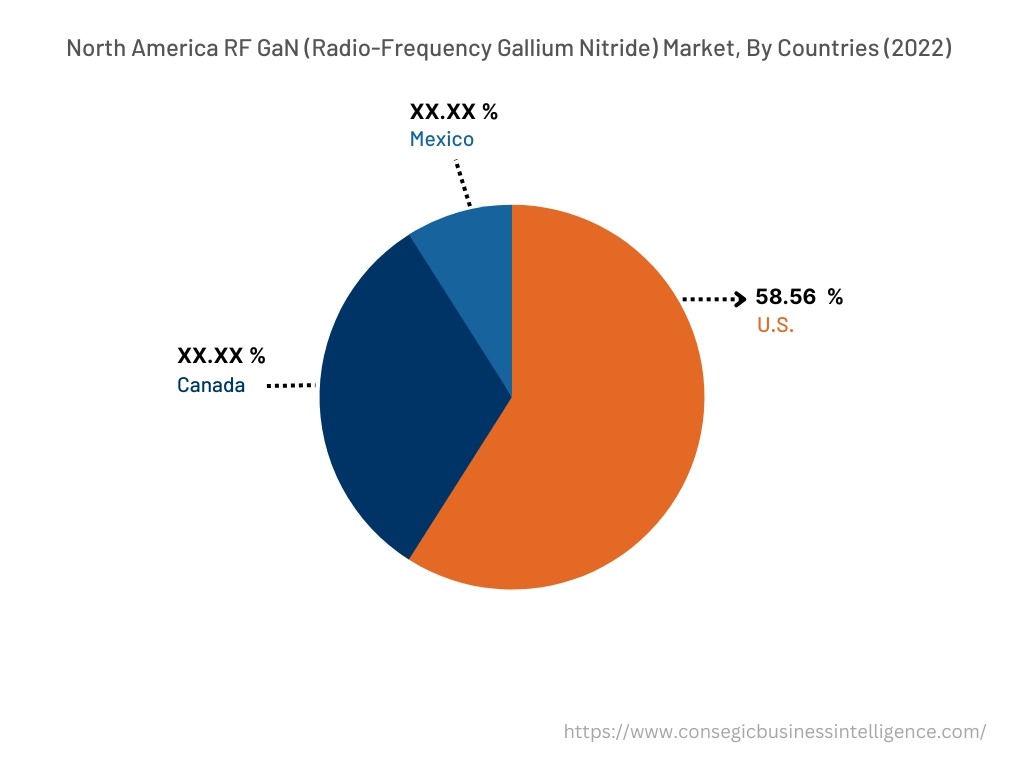
Top Key Players & Market Share Insights:
The landscape of the RF GaN (Radio-Frequency Gallium Nitride) market is highly competitive and has been examined in the report, along with complete profiles of the key players operating in the industry. In addition, the surge in innovations, acquisitions, mergers, and partnerships has further accelerated the growth of the RF GaN (Radio-Frequency Gallium Nitride) market. Major players in the market include-
- Qorvo, Inc.
- Analog Devices, Inc.
- MaxLinear
- Microsemi
- NXP Semiconductors
- Sumitomo Electric Industries, Ltd.
- Mercury Systems, Inc.
- Aethercomm
- WOLFSPEED, Inc.
- Integra Technologies Inc.
- MACOM Technology
- Mitsubishi Electric Corporation
- STMicroelectronics
- Raytheon Technologies Corporation
Recent Industry Developments :
- In June 2021, MaxLinear, Inc. and Wolfspeed, Inc. launched RF Gan-on-SiC power amplifiers. The amplifiers are designed to increase the wireless capacity of the 5G base stations by increasing data transmission speed and supporting more users.
- In July 2023, Comtech PST launched RF Amplifier nitride-based power amplifier for electronic warfare (EW) module available from 1MHz to 18GHz and 20W to multi-kilowatts output power levels.
Key Questions Answered in the Report
What is a RF GaN (Radio-Frequency Gallium Nitride)? +
A RF GaN (Radio-Frequency Gallium Nitride) is a specialized ideal substrate for high frequency related radio frequency applications including wireless communications, microwave, electrical components, among others.
What specific segmentation details are covered in the RF GaN (Radio-Frequency Gallium Nitride) market report, and how is the dominating segment impacting the market growth? +
The radar and avionics sector dominates the market in 2024 as RF GaN (Radio-Frequency Gallium Nitride) owing to its utilized in aerospace and defense sector. The RF GaN enable seamless communication and data exchange between electronic devices.
What specific segmentation details are covered in the RF GaN (Radio-Frequency Gallium Nitride) market report, and how is the fastest segment anticipated to impact the market growth? +
GaN-on-Si will emerge as the fastest by type segment owing to the increasing adoption of RF GaN in industrial application by major industries. RF GaN (Radio-Frequency Gallium Nitride) play a vital role in enabling connectivity and communication between automated systems, machines, and devices.
Which region is anticipated to witness the highest CAGR during the forecast period, 2025-2032? +
Asia Pacific is anticipated to witness the fastest CAGR during the forecast period due to the increasing investment by the government for the growth of different sectors.
